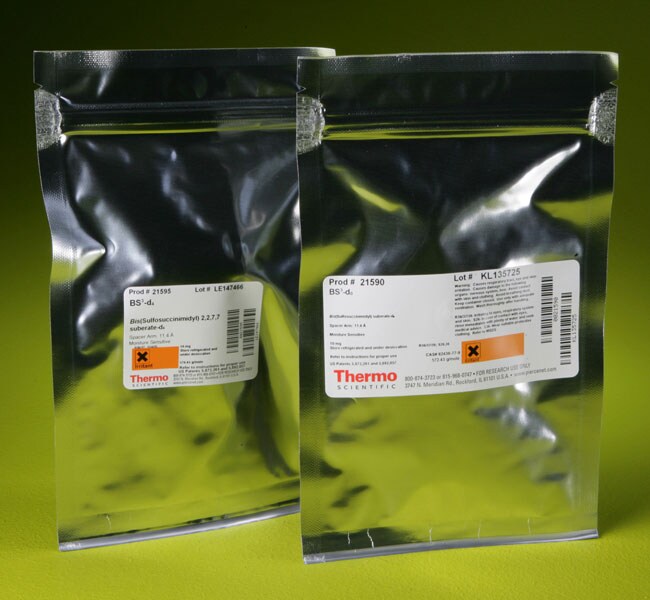
Thermo Scientific Pierce BS3-d0/d4 reagents form a matched set of heavy (deuterated) and light mass varieties of BS3 amine-reactive crosslinker that facilitates the identification of crosslinked peptides by mass spectrometry.
The BS3-d0/d4 reagents are mass-analogs of the popular BS3 crosslinker (Part No. 21580). The d-zero variety (BS3-d0) possesses ordinary hydrogen atoms while the d-four variety (BS3-d4) contains four deuterium atoms that make it exactly four hydrogen mass units heavier. When the two varieties are mixed and used to crosslink interacting proteins, distinctive mass patterns result that enable unambiguous identification of the crosslinked molecules.
Features of BS3-d0/d4 reagents:
• Deuterium-labeled BS3 and its standard hydrogen-only analog—specially manufactured for crosslinking protein structure:function analysis by mass spectrometry
• Easy identification of crosslinked fragments—peptide masses differing by 4 units unambiguously identify crosslink at specific loci within a protein interaction structure
• Application-specific instructions—help guide the first time user through the application
• Method requires only microgram amounts of protein—excellent alternative to NMR or X-ray crystallography-based methods that require large amounts of protein, special solvents or crystal formation
Addition of an equimolar mixture of two identical crosslinking agents that differ only in the number of deuterium atoms in their chemical structures provides a powerful method to identify low-abundance, singly-crosslinked peptides by mass spectrometry. Crosslinking protein interactions with BS2G-d0/d4 reagents generates distinctive mass patterns in which crosslinked peptides differ by 4 mass units after enzymatic digestion of the crosslinked protein or protein complex. Further analysis of the reaction products can yield low resolution three dimensional structure information.
BS3-d0/d4 and BS2G-d0/BS2G-d4 reagents are homobifunctional, amine-reactive, non-cleavable, water-soluble crosslinking agents with defined spacer arm lengths. These reagents can act as molecular rulers for estimation of spatial relationships in protein structure-function studies. Both light and deuterated analogs react efficiently with primary amine (—NH2) at pH 7-9 to form stable amide bonds. Proteins generally contain several primary amines in the side chain of Lysine (K) residues and the N-terminus of each polypeptide that are available as targets for the two sulfo-NHS ester reactive groups found in each of these reagents. These reagents are supplied as a sodium salt and are soluble in water at a concentration up to 10 mM.
Related Products
BS3-d4 (bis(sulfosuccinimidyl) 2,2,7,7-suberate-d4)
| Code | Description |
|---|---|
| 21590 | Catalog Number: 21590 |

